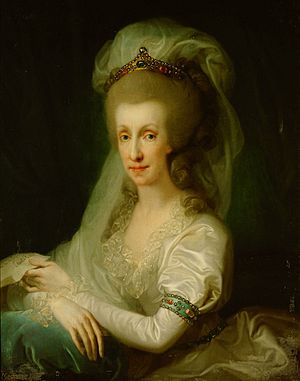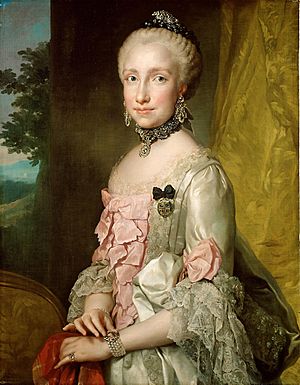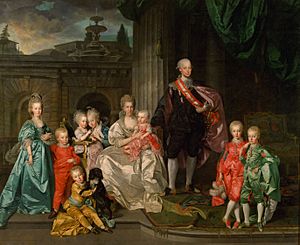Maria Luisa of Spain facts for kids
Quick facts for kids Maria Louisa |
|||||
|---|---|---|---|---|---|

Portrait by Anton Raphael Mengs
|
|||||
| Holy Roman Empress | |||||
| Tenure | 30 September 1790 – 1 March 1792 | ||||
| Grand Duchess consort of Tuscany | |||||
| Tenure | 18 August 1765 – 20 February 1790 | ||||
| Born | 24 November 1745 Palace of Portici, Naples, Kingdom of Naples |
||||
| Died | 15 May 1792 (aged 46) Hofburg Palace, Vienna, Archduchy of Austria, Holy Roman Empire |
||||
| Burial | Imperial Crypt | ||||
| Spouse | |||||
| Issue |
|
||||
|
|||||
| House | Bourbon | ||||
| Father | Charles III of Spain | ||||
| Mother | Maria Amalia of Saxony | ||||
| Religion | Roman Catholicism | ||||
Infanta Maria Luisa of Spain (born November 24, 1745 – died May 15, 1792) was a very important royal figure. She became the Holy Roman Empress, German Queen, and Queen of Hungary and Bohemia. She also held the title of Grand Duchess of Tuscany. She gained these titles by marrying Leopold II, Holy Roman Emperor.
Contents
Early Life and Family
Maria Luisa was born in Portici, a town in Campania, Italy. Her parents were Charles, who was King of Naples and Sicily, and Maria Amalia of Saxony. She was their fifth daughter and the second child who survived to adulthood.
Her father became King of Naples and Sicily in 1735. This happened after the Spanish took control of the area during the War of Polish Succession. In 1759, her father became King of Spain after his half-uncle, Ferdinand VI of Spain, passed away. At this point, Maria Luisa became known as Infanta Maria Luisa of Spain. She then moved with her family to Spain.
Life as Grand Duchess of Tuscany

Maria Luisa was first planned to marry Joseph II, Holy Roman Emperor, who would later become an emperor. However, Louis XV of France did not approve of this marriage. He wanted Joseph to marry his granddaughter, Princess Isabella of Parma, instead.
On February 16, 1764, Maria Luisa married Leopold in a ceremony held by proxy in Madrid. Leopold was the third son of Empress Maria Theresa I and Francis, Duke of Lorraine. He was also the next in line to become the ruler of the Grand Duchy of Tuscany. Before her marriage, Maria Luisa had to give up her rights to the Spanish throne. This was a wish from her father.
After her proxy wedding, she traveled to Austria. The journey took her through Barcelona, Genoa, and Bolzano. The next year, on August 5, she married Leopold in person in Innsbruck. Just a few days later, Emperor Francis died. This made Maria Luisa's husband the new Grand Duke of Tuscany. The newly married couple then moved to Florence, where they lived for the next twenty-five years. They arrived in Florence on September 13, 1765, and settled in the Palazzo Pitti.
Maria Luisa was described as a beautiful woman with blue eyes. She was known for her lively charm, being down-to-earth, and her kind nature. Her warm and friendly personality was a contrast to Leopold's somewhat reserved nature. She was raised to be a strong and loyal wife, especially during pregnancies. Their marriage was considered happy, and Maria Luisa was a very supportive partner.
As Grand Duchess of Tuscany, Maria Luisa quickly earned respect. During a famine in 1765, she helped the poor by providing food and medical aid. People saw her as a perfect example of a virtuous woman. She was never officially crowned as Grand Duchess. However, she was present when Leopold was crowned in July 1768. She also traveled with Leopold and her sister-in-law, Maria Carolina, to Naples for Maria Carolina's wedding to Maria Luisa's brother.
Maria Luisa and Leopold did not enjoy formal events or grand court life. Leopold focused on politics and his personal interests. Maria Luisa mostly stayed away from high society. She dedicated herself to raising her children. They gave their children a very free upbringing, away from strict court rules. They often took them on trips to the countryside and the coast. Maria Luisa preferred a small group of friends and was not well-known among the local nobles.
Becoming Holy Roman Empress
In 1790, Leopold's brother, Joseph II, Holy Roman Emperor, died without children. This meant Maria Luisa's husband inherited the lands of the House of Habsburg in Central Europe. Soon after, he was chosen to be the Holy Roman Emperor. He took the name Leopold II. The new Emperor moved his family to Vienna. There, Maria Luisa became the imperial consort, which means the wife of the emperor. She was the second to last person to hold this title.
Leopold died just two years later, on March 1, 1792. Maria Luisa passed away less than three months after her husband, on May 15, 1792. She did not live long enough to see her oldest son, Francis, become the last Holy Roman Emperor. She was buried next to her husband in the Capuchin Crypt. Her heart is in the Loreto Chapel in Vienna, and her internal organs are in the Ducal Crypt.
Mozart's opera La clemenza di Tito was created for the celebrations of Maria Luisa and Leopold's coronation. They were crowned king and queen of Bohemia in Prague on September 6, 1791. Some stories say Maria Luisa disliked Mozart's opera, calling it "German rubbish." However, this claim only appeared much later, in a book published in 1871.
Her Children

Maria Luisa and Leopold had many children:
- Maria Theresa of Austria (1767–1827), who married Anton of Saxony.
- Francis II, Holy Roman Emperor (1768–1835), who became the Holy Roman Emperor. He married four times and had children.
- Ferdinand III, Grand Duke of Tuscany (1769–1824), who became Grand Duke of Tuscany. He married twice and had children.
- Maria Anna of Austria (1770–1809), who never married.
- Charles of Austria (1771–1847), who married Henrietta of Nassau-Weilburg and had children.
- Alexander Leopold of Austria (1772–1795), who died unmarried.
- Albrecht Johann Joseph of Austria (1773–1774), who died as a baby.
- Maximilian of Austria (1774–1778), who died as a child.
- Joseph of Austria (1776–1847), who married three times and had children.
- Maria Clementina of Austria (1777–1801), who married Francis I of the Two Sicilies and had children.
- Anton of Austria (1779–1835), who never married. He was also a Grand Master of the Teutonic Knights.
- Maria Amalia of Austria (1780–1798), who never married.
- Johann of Austria (1782–1859), who married Anna Plochl. Their children were given the title Counts of Meran.
- Rainer of Austria (1783–1853), who married Princess Elisabeth of Savoy-Carignano and had children.
- Louis of Austria (1784–1864), who never married.
- Rudolph of Austria (1788–1831), who never married.
See also
 In Spanish: María Luisa de Borbón para niños
In Spanish: María Luisa de Borbón para niños

